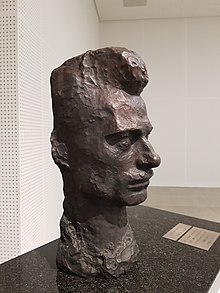Nakahara Teijirō
Nakahara Teijirō ( Japanese 中原 悌 二郎 ; born October 4, 1888 in the city of Kushiro ( Hokkaidō ); died January 7, 1921 ) was a Japanese sculptor of the Taishō period .
life and work
Nakahara Teijirō moved to Tōkyō in 1905 and studied drawing and watercolor painting at the schools of the artists' associations Hakuba-kai (白馬 会) and Taiheiyō Gakai (太平洋 画 会). When he met Ogiwara Morie in 1908 , he came into contact with Rodin's sculptures and decided to become a sculptor. He studied under Shinkai Taketaro .
In 1910 Nakahara submitted his sculpture "Head of an Old Man" (老人 の 首) to the 4th exhibition of the Ministry of Culture, the "Mombushō Bijutsu Tenrankai" (文部省 美術展 覧 会), which was also accepted. From 1916 onwards he exhibited his works at the annual Nihon Bijutsuin exhibition and became an associate member of this institution.
Since Nakahara died early of tuberculosis, there are very few works by him. But what is there shows his great talent for sculpture. One of his best works is the sculpture "Young Caucasians" (若 き コ ー カ ス 人, Wakai kōkasu-jin) from 1919.
In the city of Asahikawa there is a museum dedicated to the memory of Nakahara, the "Nakahara Teijirō Kinen Asahikawashi Chōkoku Bijutsukan" (中原 悌 二郎 記念 旭川 市 彫刻 美術館). The “Nakahara Teijirō Prize” (中原 悌 二郎 賞) has been awarded to young sculptors since 1970.
Remarks
- ↑ Owned by the Hakone Open Air Museum . At that time, the Europeans were sometimes referred to as "Caucasians".
literature
- Tazawa, Yutaka: Nakahara Teijirō . In: Biographical Dictionary of Japanese Art. Kodansha International, 1981. ISBN 0-87011-488-3 .
- Laurance P. Roberts: Nakahara Teijirō . In: A Dictionary of Japanese Artists. Weatherhill, 1976. ISBN 0-8348-0113-2 .
| personal data | |
|---|---|
| SURNAME | Nakahara, Teijirō |
| ALTERNATIVE NAMES | 中原 悌 二郎 (Japanese) |
| BRIEF DESCRIPTION | Japanese sculptor |
| DATE OF BIRTH | October 4, 1888 |
| PLACE OF BIRTH | Kushiro |
| DATE OF DEATH | January 7, 1921 |
